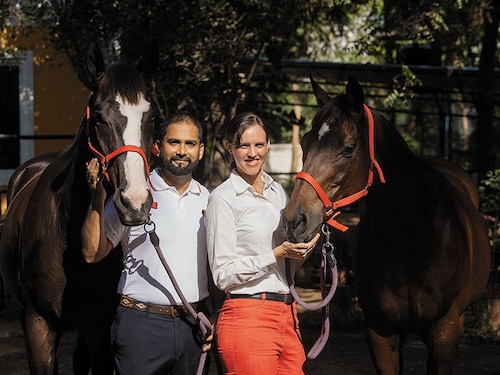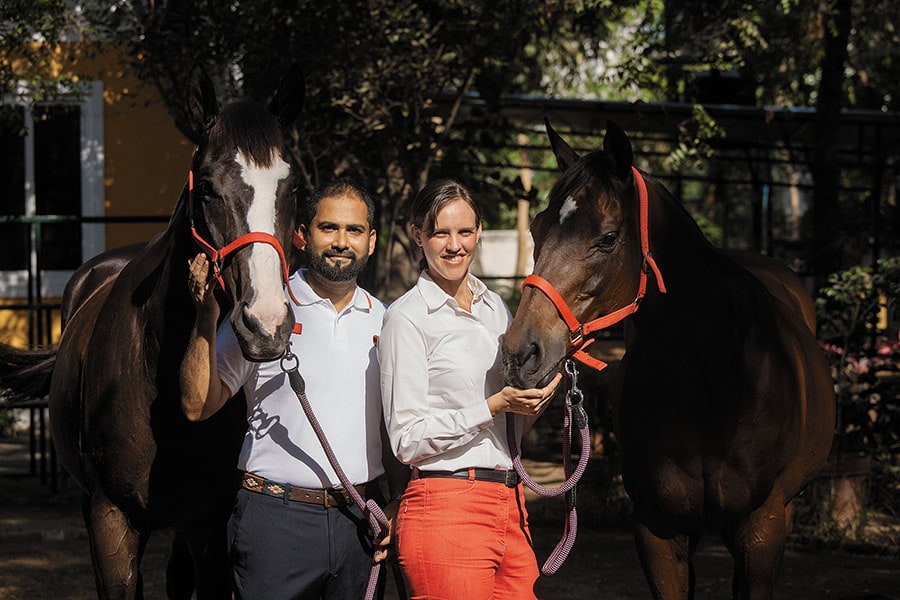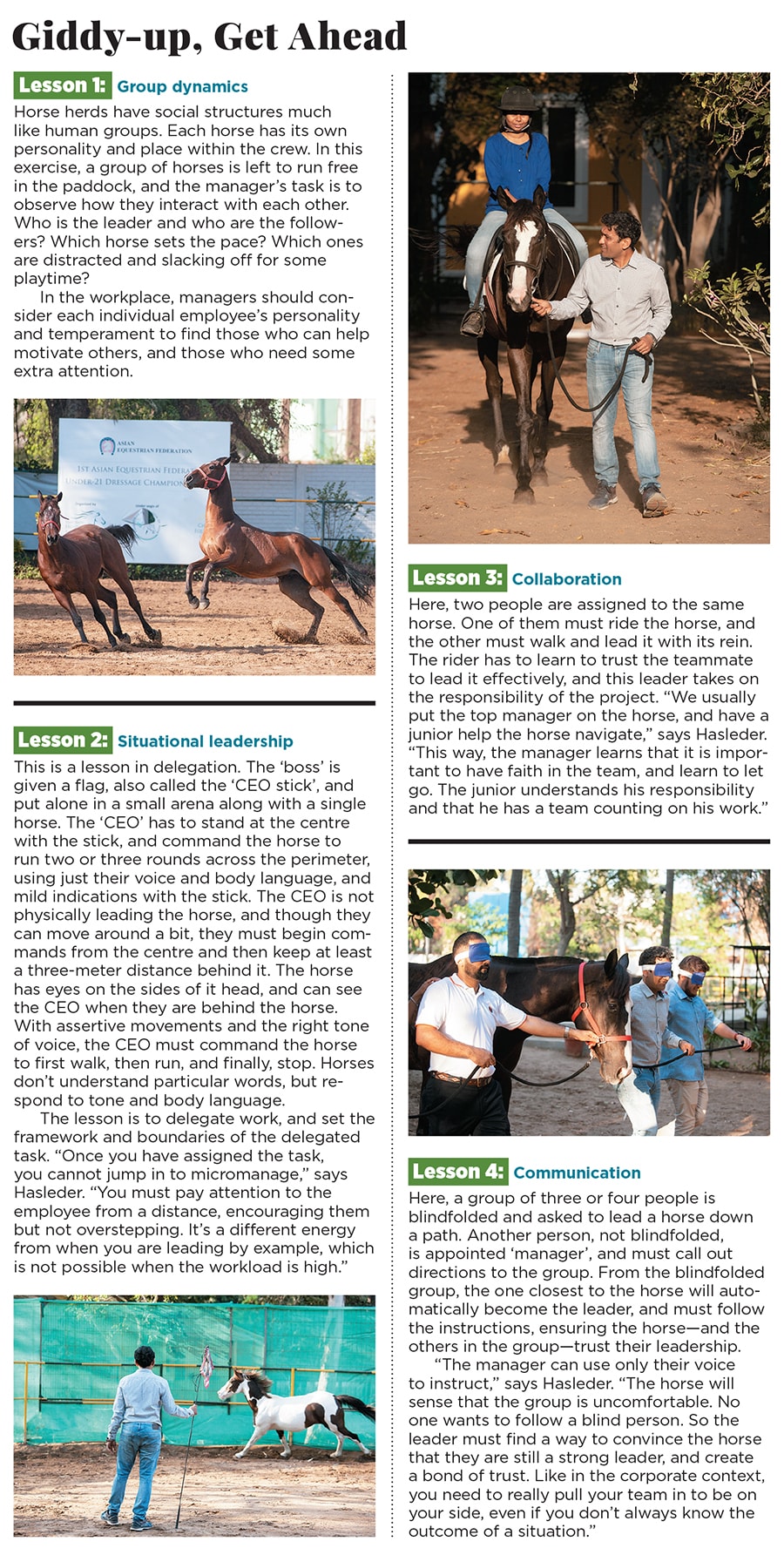Get leadership lessons—from horses
A new German leadership programme takes you out of the boardroom and into the paddock—it uses horses to simulate corporate dynamics and help leaders learn key skills in becoming better people managers


 Isabelle Hasleder and Dhruv Futnani share a love for horses
Isabelle Hasleder and Dhruv Futnani share a love for horses
Image: P Ravikumar for Forbes India[br]Star World. Moonlight. Barfi. Vijay.
This isn’t a TV guide list, but the roster of the majestic four-legged ‘teachers’ who will train you to become a better manager at work. No, really.
For the first time in India, a German programme trains mid-level and top-level corporate managers to work and inspire their team, using horses as stand-in employees. The idea is that horses, which are a highly sensitive species, will respond to your instructions, energy and body language instantly, and have you accomplish your tasks only if you project all of these in the right way.
Many of these lessons and non-verbal cues can be adapted to the corporate scenario, too, teaching managers how to refresh their leadership styles to inspire growth from their team. You know what they say about the horse—you can take it to the water... here’s where you learn how to also make it drink.
The original training programme was devised about two decades ago by Gerhard Jes Krebs, a pioneer in horse-assisted education, and is administered by the EAHAE institute in Germany. It has been adopted over the years in the US, UK, Germany, France, China, Venezuela, Italy, Kazakhstan and other countries. In India, the course is taught by Isabelle Hasleder—a corporate manager from Austria, who is the only EAHAE-certified trainer in the country. The course has been taught in India since October 2018, with options of a one-day or two-day course.
“Horses, unlike dogs, do not look at you as a ‘master’,” says Hasleder. “You have to earn their trust, and you have to earn it repeatedly. They do not form personal relationships with any single person to do their bidding, so in each exercise, they will give you immediate feedback on whether your leadership style is working, and you have to correct yourself or find other solutions, instantly.”
*****
I began my day at the paddock with a grey-white, seemingly gentle steed called Star World. The task looked simple enough: Lead by example. Hold the horse by its reins and walk him through an obstacle course, laid out in a twisting path. The reality was more complex. One, I learned quickly, and the hard way, that keeping the right pace is essential—if things seemed to be on track and I started to absentmindedly linger, the horse could wander off course in less than a second, distracted by some mud to examine or leaves to chew on. If I remained alert, proactive and with my eye on the goal, so would he.
The idea of the exercise, says Hasleder, is to replicate how seasoned managers often amble along and do things as they have always been done. “Initially, most people will go slow with the horse, then realise that they are not showing them much motivation. Meanwhile, the horse will go off track, as an employee would,” she adds. “The horse does not care how much experience you have or how many years you have held the job. As soon as you show more proactivity and remain engaged yourself, the horse will also engage and take your instructions.”
“Initially, most people will go slow with the horse, then realise that they are not showing them much motivation. Meanwhile, the horse will go off track, as an employee would,” she adds. “The horse does not care how much experience you have or how many years you have held the job. As soon as you show more proactivity and remain engaged yourself, the horse will also engage and take your instructions.”
Hasleder, who has always loved horses since she was gifted her first horse at age 12 by her father, came to India on a project to study engineering over 12 years ago. She stayed on and went on to marry architect Dhruv Futnani, bonding over their shared love for horses—their home is studded with wedding photos of the couple, dressed in full bridal finery, riding into the ceremony atop regal stallions.
Futnani’s father, Kishore, is well-known in the Indian horse-racing circuit, and the family owns, and lives on, a farmhouse and equestrian centre in Chennai along with 50 horses, ranging from ponies to well-bred international race breeds—and 12 dogs for company. They also run a riding school on the property.
While Hasleder’s company, HQ Leadership India, is headquartered in Chennai, she and her team have recently begun to offer the courses in Bengaluru and Mumbai, too, partnering with local riding clubs.
Hasleder earlier worked at auto giant BMW in Chennai, where her job was to look at how to make the operations and logistics teams more agile. Out of interest, she did the EAHAE training in Germany in March 2017, and returned to India and delivered the horse-assisted lessons for her teams at BMW. Soon, word spread and other companies got in touch. Quite organically, she says, she decided to quit her job at BMW in July 2018, to focus on growing HQ Leadership India as a full-fledged corporate training agency. So far, in addition to providing training at top auto companies, Hasleder has trained various levels of managers from multinational companies such as PayPal, Cisco, Saksoft and Fiat Chrysler Automotive.
Nicholas Small, vice president—global operations and asset management at Cisco, took the training on a visit to India and says it has helped him make adjustments in his leadership style, to build stronger bonds with his employees, and work hard to identify communication or connection gaps.
“The course allowed me to better understand the importance of trust, awareness and communication in unifying teams and driving results,” says Small. “This introduction of horses and their ability to sense and respond to a person’s intentions and emotions helped team members who took the course learn to communicate more effectively, face potential fears of the unknown, and manage their emotions to drive better actions and outcomes. Combining the majesty of these animals with the demonstration of key leadership provides unparalleled opportunities for learning in motion.”
Trot to gallop
The big difference between training managers in India versus those in Europe, says Hasleder, is that most people in Europe have had horse interactions before. “Here, most people have never touched one, and definitely not in their adult lives,” she says. “So there’s a lot of apprehension in the beginning. We slowly introduce people to the horses and explain safety precautions, then we go on to topics that the clients really want to take up.”
The companies can select their own agenda exercises, custom-fit for the team they would like to train. So while some opt for lessons in collaboration and how to be better at validation, others could choose to focus on group dynamics and delegation.
“It could also just be that the company wants to bring in a new perspective for their top management,” Hasleder adds. “A lot of these people have gone through multiple corporate trainings in the past, and there’s very little new knowledge we can give them. What we can offer, however, is a different perspective, with a new training methodology that inspires you to experiment and renew your vision.”
Hasleder recounts stories of multiple high-level managers who start out aloof, but once they begin to interact with the horses, their countenance changes: They behave much younger and are more active. “We had a lady who was over 50 years old and really uncomfortable with the thought of getting on a horse. It took three trainers five full minutes to convince her to get on, and at the end, she was beaming,” she says. “When you physically get over a challenge, you are much more likely to be open to experimenting in the future. You have experienced the positive impact of overcoming certain fears in a very tangible way.”
It’s difficult to get new ideas when you sit in front of the computer the whole time, she adds. “With classroom trainings, companies often face attendance issues—here, out in the field where you can be with animals and hear the birds around you, we have more and more people wanting to come back.”
First Published: Apr 30, 2019, 18:19
Subscribe Now